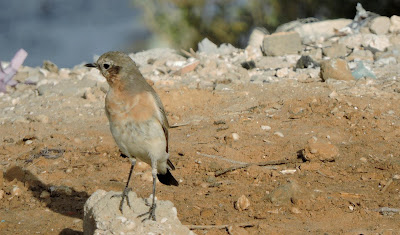I soon noticed a grey heron of the sub-species monicae. This is otherwise known as pallid heron because it is paler than any other grey heron.
monicae grey heron
A few minutes into my visit the waders became very agitated as a lanner falcon swooped down.
very distant view of lanner falcon
It is rather common in Mauritania. I wonder how common it would be in the Gulf if falconers had n't taken so many out of circulation over the generations.
West Nouakchott pools
West Nouakchott pools is only 250 metres away from the edge of Cinquieme Gardens. The gardens are fresh water with much tree cover. They are fresh water because of the way the aquifers work in the city. They are supplied by the sea and by human waste water. The ground does a very effective job of cleaning the water up. Hence the fresh water nature of the two water bodies furthest away from the sea. The problem with Cinquieme is it is not safe mostly because of the hiding places for bad men. This is even though the city as a whole is very peaceful and basically safer than most others in sub-Saharan countries.
Returning to the pools, once again ruff were present. I haven't visited these pools often but every time this species has been there.
ruff
sleeping greenshank
Little stint and common ringed plover were arguably the commonest waders. Indeed in nearly all water bodies, whether salt water or fresh, around the city these two waders are extremely common in winter.
grey plover
white wagtail
Plenty of white wagtail make it this far south in winter and are most easily seen next to water.
The second water body visited last weekend was North Nouakchott Lake on Saturday morning and breifly again on Sunday evening.
I am persistently visiting this lake which is my local patch within walking distance of my house.
I don't expect it to change every day but I do want to observe any change when it does occur.
While there were no great changes on Saturday since visits within the previous seven days, I did notice that the little grebe are getting more territorial. I expect the breeding season to start soon.
two little grebe fighting
Fights between little grebe are very common at the moment. By the way, a wintering black-necked grebe was still present.
northern pintail
I can't believe they have headed north given the colder than average winter in southern Europe this year. That only leaves south.
soiled European spoonbill
Two European spoonbill were present. Unfortunately one has been heavily soiled.
Young coot
Unlike the little grebe which appears to have a discrete breeding season here, coot of all ages can be seen. These vary from day old chicks to young birds and adults. This bird and its sibling were very confiding.
squacco heron 1
There has been a single squacco heron on site for the past ten days. It has been scared easily but on Saturday it was more relaxed and finally allowed me reasonable photographs.
squacco heron
African swamphen are seen on almost every trip. Like the coot and moorhen they are confiding. There is no sign of hunting and shooting at the lake. This has clearly effected these birds' attitude towards people.
African swamphen
On Sunday late afternoon, I return to the lake. The idea was to look for crakes again. I tried more spots and worked hard.
Baillon's crake
The Baillon's crake was seen at the same spot and time as last time. It is a good bird anytime. However there was no hint of any other crake. The passage season may well be different.
The other piece of good news from Sunday was the sighting of a sedge warbler. My last one at the lake was in late November. I suspect it has wintered here but early passage is possible. The first barn swallow, sand martin and house martin that evening tells me the passage has begun for some brave birds.
























































